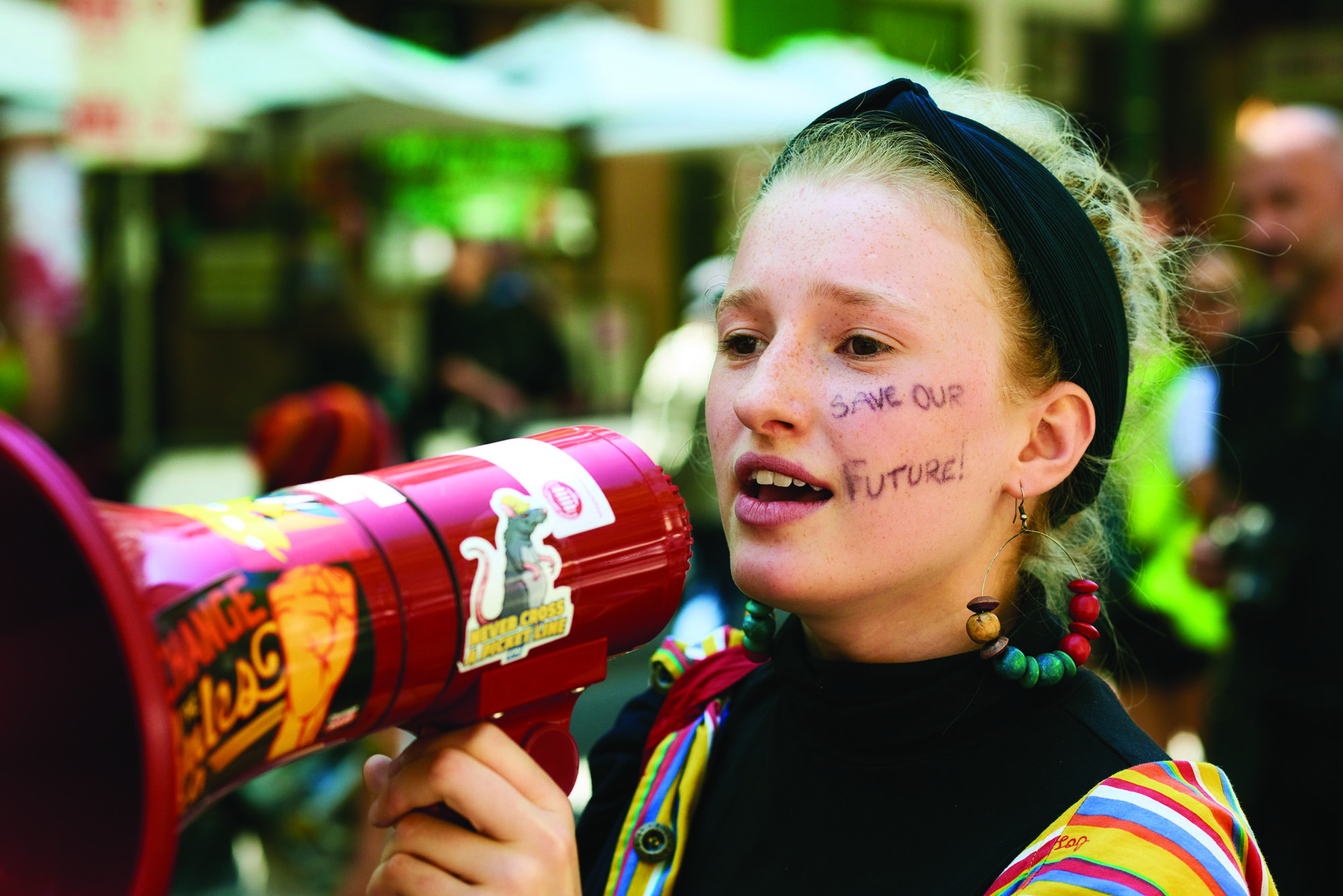The opening scenes of Wild Things (Sally Ingleton, 2020) show the lush environment of the Tarkine in the Tasmanian summer. The area is, the documentary tells us, the second-largest tract of cool temperate rainforest in the world – and yet only 6 per cent of this area is fully protected from logging.
The threat to the forest, however, is not the primary focus of the film. Instead, Wild Things depicts a year in the heart of contemporary activist campaigns in Australia, revealing the work and motivations of new generations of environmental activists. Their stories constitute the three threads of the documentary. In Tasmania, the film follows Lisa Searle, a GP who has for the last thirteen years been immersed in the work of protecting the state’s forests through processes of monitoring and blockading endangered areas. Elsewhere, it observes two founders of the local School Strike 4 Climate movement, fourteen-year-olds Milou Albrecht and Harriet O’Shea Carre, who, after initially mobilising their classmates at their school in Castlemaine in Victoria, were instrumental in the massive street marches that were held around Australia in 2019. The third narrative of Wild Things takes us to central Queensland’s Camp Binbee, the base for the Frontline Action on Coal campaign and the temporary home for a group of volunteers committed to stopping the construction of multinational corporation Adani’s massive Carmichael coalmine. In the Tasmanian and central Queensland sections of the documentary, there is an emphasis on the connection between activism and place, or the way bodies might mobilise within the environments they seek to defend. In the case of School Strike, the focus is on activist networks – local and global alike – and their capacity to summon a wider collective response. In each case, this documentary asks the viewer to identify with the people who are passionately committed to changing the course of environmental destruction.
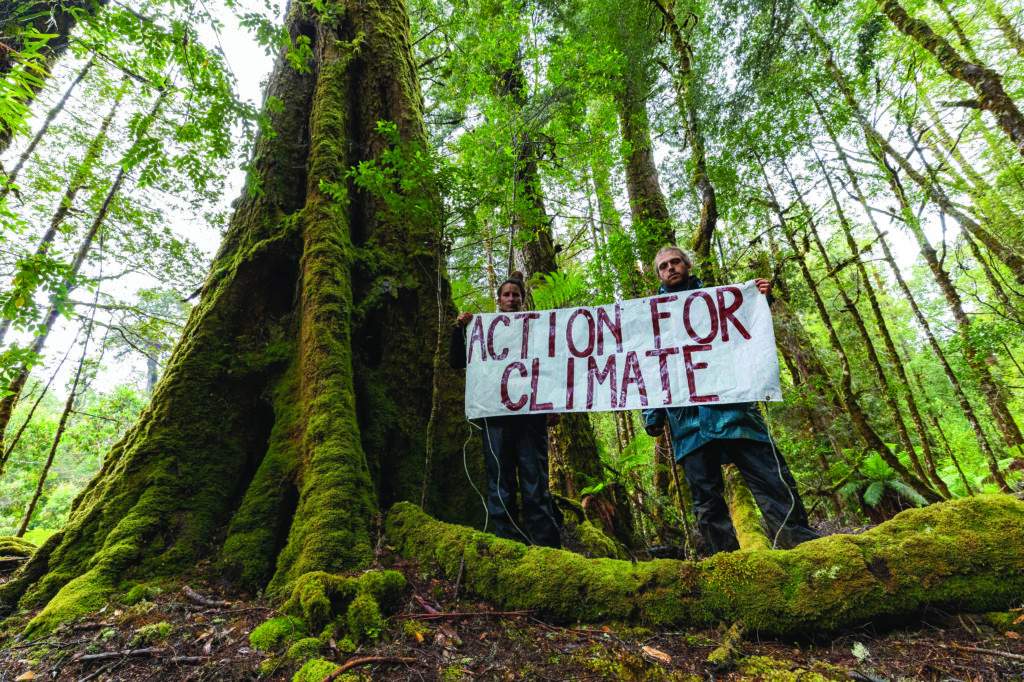
Wild Things sits squarely within a newly energised subgenre of environmental documentary in Australia. In the first decade of the twenty-first century, the United States led the way in this area, with a wave of documentaries that began with An Inconvenient Truth (Davis Guggenheim) in 2006[1]Charles Musser, ‘Trauma, Truth and the Environmental Documentary’, in Anil Narine (ed.), Eco-Trauma Cinema, Routledge, New York & London, 2014, p. 60. and gained ground thanks to the ‘green’ focus of the 2009 Sundance Film Festival, where titles such as The End of the Line (Rupert Murray) and The Cove (Louie Psihoyos) premiered.[2]ibid., p. 46. Production has only accelerated over the last decade. Australian filmmakers were a little slower to catch on, but there has been a clear upsurge in feature-length environmental documentaries here that includes not only Damon Gameau’s high-profile and hopeful exploration of new approaches and solutions to climate change 2040 (2019),[3]See Rebekah Brammer, ‘Seeds of Change: Damon Gameau’s 2040 and Sustainable Futures’, Metro, no. 201, 2019, pp. 76–80. but also Youth on Strike! (Rob Innes, 2020), The Leadership (Ili Baré, 2020)[4]See Debbie Zhou, ‘All at Sea: Confronting Exclusion in Ili Baré’s The Leadership’, in this issue of Metro, pp. 40–5. and the upcoming Dark Water: Battle on the Franklin (Kasimir Burgess), as well as earlier films such as Frackman (Richard Todd, 2015) and Blue (Karina Holden, 2017).[5]This upsurge has coincided with the work of the Documentary Australia Foundation (DAF) in facilitating the rise of philanthropic funding for documentary in Australia. With the broadcaster-presale model increasingly narrow and competitive, DAF has addressed an important need in Australian documentary culture. In particular, the Good Pitch Australia initiative (2014–2019) has facilitated the production of a number of high-profile documentaries, such as Frackman, 2040, The Leadership and Blue. See the Good Pitch Australia website, <https://goodpitch2australia.com.au>, accessed 29 October 2020. Ingleton’s own filmmaking predated this trend by being consistently committed to addressing environmental issues and wildlife themes: her documentary work has focused on the degradation of coral reefs in Muddy Waters: Life and Death on the Great Barrier Reef (2003) and Acid Ocean (2014); the importance of ancient seeds and future food security in Seed Hunter (2008); and, in work she has produced, such as Kangaroo Mob (Steve Westh, 2011), Possum Wars (Bruce Permezel, 2013) and the 2013 TV series Devil Island, the critical relationship between wildlife and people.
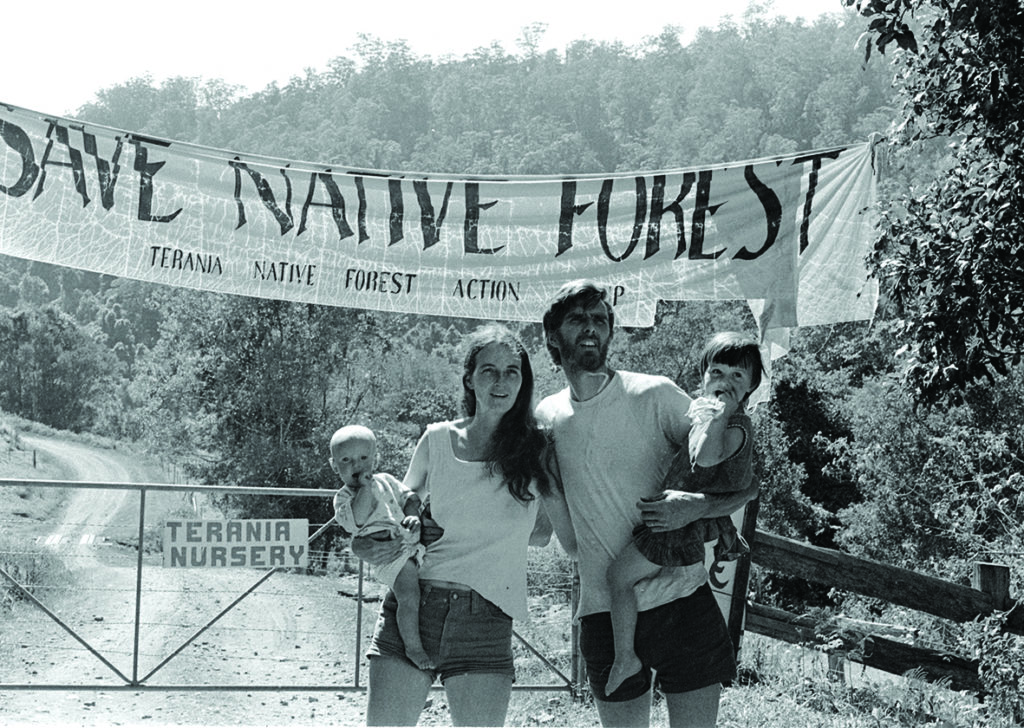
Wild Things focuses on the people involved in environmental campaigns, their motivations and their diverse backgrounds. For this reason, its environmental politics are tied to the specificity of personal accounts rather than detailed arguments about anthropogenic environmental impacts. However, it is not a documentary that relies exclusively on interviews and archival footage. At the core of the film’s style is its use of striking observational footage that captures the sensation and spectacle of being on the front line of a political action. One sequence depicts activists confronted by police while chained to machines or camped high in a tree in the Tarkine forest in order to obstruct logging crews. In another, protesters picket a depot in Townsville as a worker attempts to drive a truck through them and enter the compound. Others show the School Strike founders as they prepare to address a crowd of tens of thousands at a rally in central Melbourne against inaction on climate change. In these moments and others, the film shows bodies in the frame in physical confrontation, depicting the work of political activism rather than describing it. Indeed, the film conveys stories of activism and the environment without the assistance of a voiceover narration. The viewer is asked to build their own meaning from the scenes presented, the captions on screen and the words of interviewees.
This kind of documentary filmmaking that is anchored in a protest movement has clear precedents. In 1984, critic Thomas Waugh used the term ‘committed documentary’ to describe ‘a specific ideological undertaking, a declaration of solidarity with the goal of radical socio-political transformation’.[6]Thomas Waugh, ‘Introduction’, in Waugh (ed.), Show Us Life: Toward a History and Aesthetics of the Committed Documentary, The Scarecrow Press, Metuchen, NJ, 1984, p. xiv. Necessarily, political documentaries are not concerned with objectively weighing up sides of a debate – their purpose is altogether different, and such films should be evaluated in terms of the specificity of that endeavour. There is a long history of filmmakers taking up a position within a social movement, explicitly locating themselves on one side of the political divide and eschewing the notion of the distanced observer. This mode of filmmaking, one that seeks to participate in social and political transformation, is also one that endeavours to rally and construct a public. In the case of Wild Things, its public is not intended to be those who favour the status quo or deny that the climate is warming.
There is a long history of filmmakers taking up a position within a social movement, explicitly locating themselves on one side of the political divide and eschewing the notion of the distanced observer.
Importantly, Wild Things’ agenda is to not only show the efficacy of contemporary activism, but also convey a history of campaigns that have succeeded in protecting the Australian environment. To this end, a sequence of interviews and historical footage documents four important moments from the early 1970s to the 1990s: the green bans in Sydney; the Terania Creek rainforest protests; the Franklin River campaign; and the Jabiluka blockade. Contemporary interviews with key participants (including former Australian Greens party leader Bob Brown) offer a valuable record of how events unfolded from the perspective of those who were directly involved. Perhaps most remarkable, however, is the archival footage from the time, including tense discussions with police and a young Brown detailing how he was physically attacked by irate locals. These clips serve to remind us that filmmakers were on the front line for all of these actions, recording visual proof that the events occurred and the manner in which those present on either side conducted themselves.
Offering a different perspective on the history of the Australian environment is Ken Dodd, a Birri Gubba elder from central Queensland who appears at key points in Wild Things. He reflects on the earliest coalmines, dating back to the 1850s, which were built on land that his ancestors had already been removed from. Dodd brings a crucial long-range perspective to extraction industries, stating that ‘the old people’ had known for a long time that mining would throw nature out of balance: ‘It will poison the waters, it will poison the air and it will poison the people.’
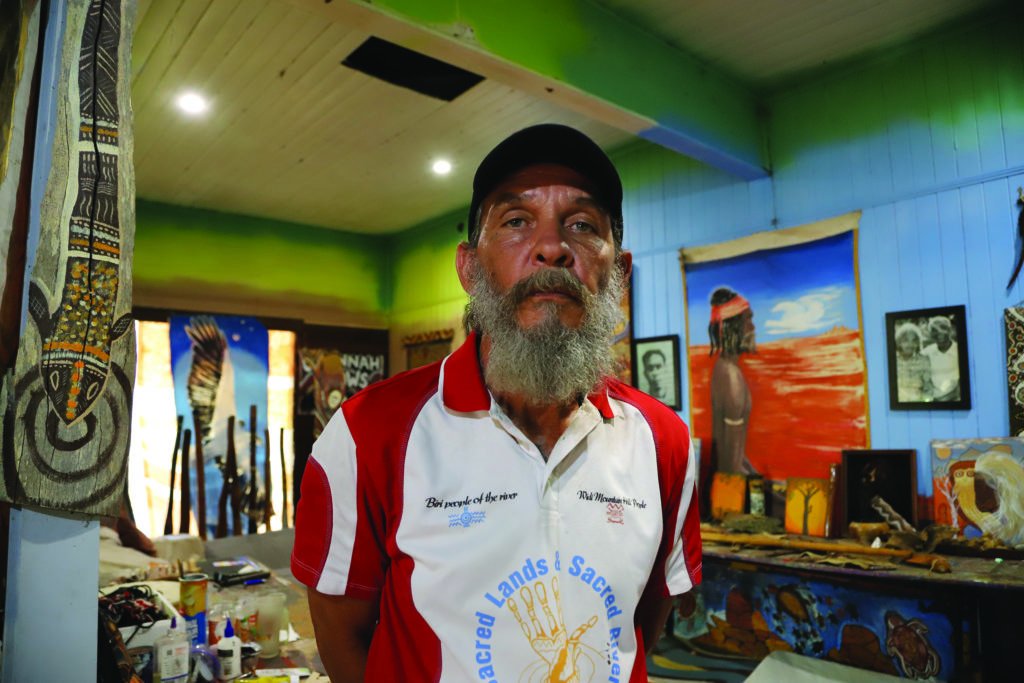
Wild Things acknowledges the importance of historical contexts, whether they be colonialism, environmental-justice campaigns or the rich lineage of committed documentary. I suggest that the film also signals a new modality of environmental documentary. The decision to explore not one but three campaigns over the course of a year and in different parts of the continent represents a mammoth undertaking. Adding to this, Ingleton and her production company, 360 Degree Films, are based in Darwin; thus, the production of the film spanned four states/territories as well as an excursion to New York to follow O’Shea Carre to a meeting at the United Nations headquarters with Swedish environmental activist Greta Thunberg. Ingleton was unable to maintain an ongoing presence at Camp Binbee or the Tarkine, creating challenges in documenting the often-spontaneous work of activism in these places. The only way to record valuable footage of events occurring on the blockades was for those on the ground to capture it themselves on mobile phones. The resulting film thus features not only on-location observational footage of protest action, but also the intimacy and ‘grittiness’ that come with self-shot phone recordings. Talking about how this occurred, Ingleton recalls one moment in the production when Searle called her in Darwin at 4am, noting that she was in a suspended structure – a ‘tripod’ – high in a tree that had been prepared for an imminent blockade. Ingleton urged her to record the moment, she tells me; the result is a low-lit, grainy but intimate shot showing the viewer the experience of being suspended high in a forest alone, waiting for the unknown.
The potential for the self-presentation of an activist perspective has increased over the last five to ten years as the quality of phone cameras has improved.
The potential for the self-presentation of an activist perspective has increased over the last five to ten years as the quality of phone cameras has improved. Another feature that locates the film in a new epoch for environmental documentary is its recognition of the influential role of social media in activist organisations. This is reflected on screen with the superimposition of text messages or posts on the forest vista. All give words of support to Searle and her companions, offering visual representation to the movement’s reliance on a social-media following to sustain its efforts. This is particularly the case for environmental activism, as those involved are often located in geographically remote areas. Together, Wild Things’ use of phone footage and references to social media function as stylistic devices that enable the film to reflect the technological changes that are, in turn, shaping activism.
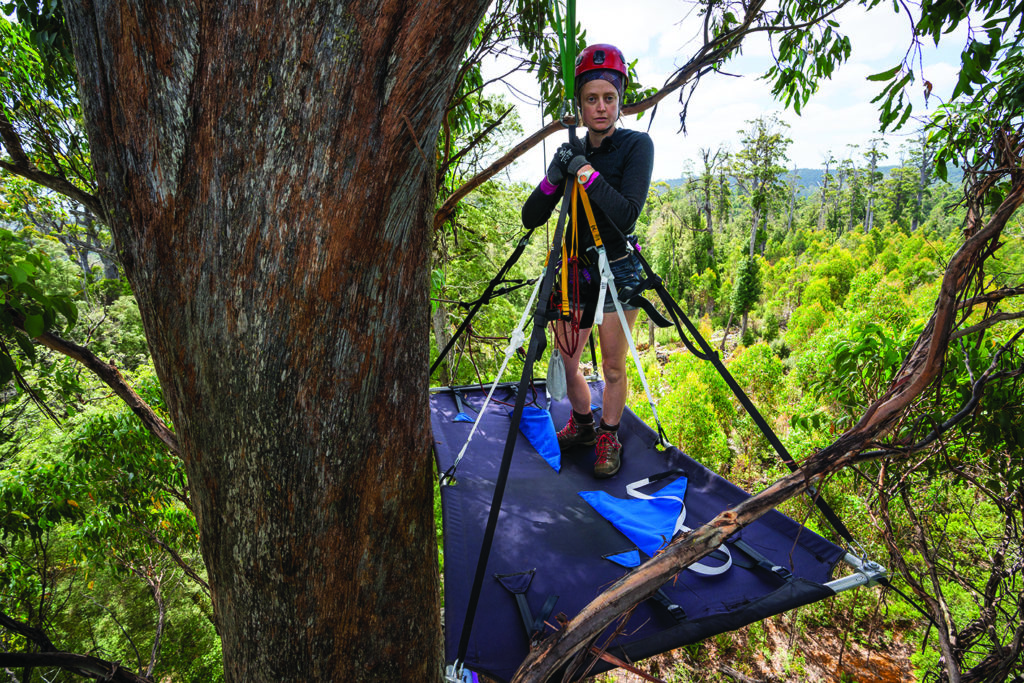
Another striking aspect of the film that reflects the changing face of environmental action is its focus on women’s voices and female leadership. In Wild Things, Searle is the key character connecting the viewer to the forest and those who seek to protect it, and the initiators of School Strike are two articulate and impressive young women. While the depiction of the Frontline Action on Coal campaign features an ensemble group, thus capturing the ethos of collectivity at Camp Binbee (with a young man, Andy Paine, a notable focus for the film), several women there voice their deeply held convictions about protecting the environment. This includes a handful of retired women, some well into their seventies, who are also shown ‘manning’ the blockades. Wild Things effectively demonstrates that environmental action in Australia is now a multigenerational movement, with women at the forefront.
Ingleton notes that her aim was not to focus on women in particular or skew the film in that direction. Rather, she says, women became the main protagonists because they were already central to the movement, in the case of School Strike, or were simply the most impressive, charismatic and articulate subjects she encountered, such as Searle. In this respect, the film sits alongside examples such as Blue, The Leadership and anti–coal seam gas extraction documentary short Knitting Nannas (Rani Brown, 2014) in its depiction of women taking key roles in environmental issues. Ecofeminist scholar Greta Gaard writes that ‘women comprise an estimated 60–80% of members in environmental organizations worldwide’.[7]Greta Gaard, ‘Feminism and Environmental Justice’, Ryan Holifield, Jayajit Chakraborty & Gordon Walker (eds), The Routledge Handbook of Environmental Justice, Routledge, New York & London, 2017, p. 74. As Gaard notes, there is a range of reasons, tied to specific cultural and economic contexts, why women have a higher stake in protecting the environment. Nevertheless, this figure shows why it is unsurprising that women became pivotal to the concerns of a film such as Wild Things. It also suggests that women are a key audience for the film.
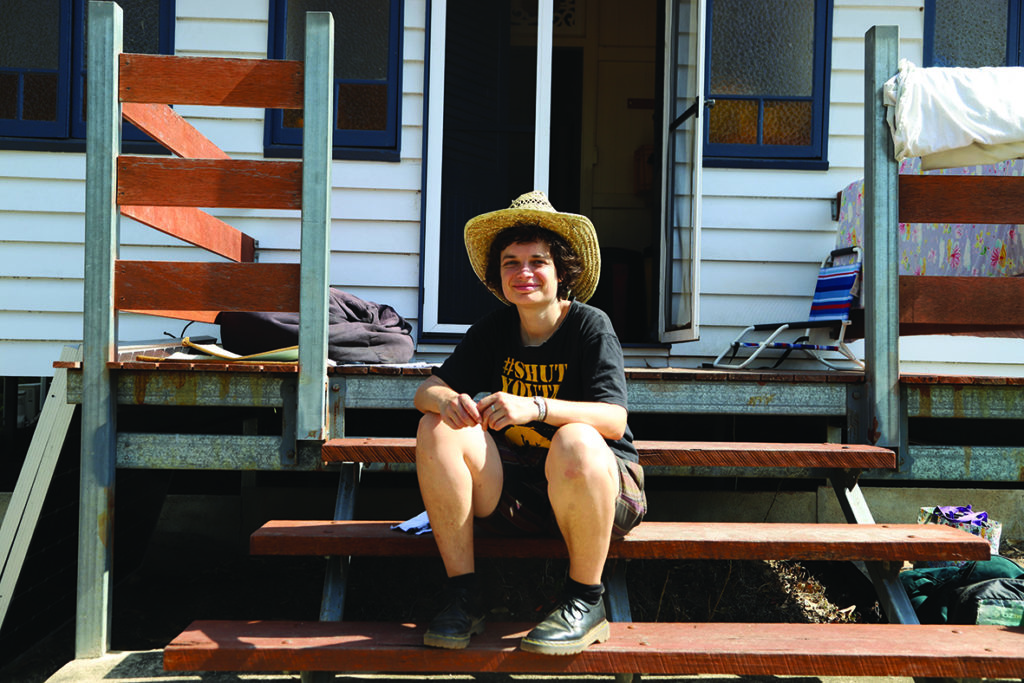
Wild Things is an important film that offers a wide-angle perspective of Australian environmental movements. It works directly to counter the overwhelm that can come with reports of the constant decline and human disregard of the natural world. In so doing, it seeks to galvanise young (and not-so-young) people by showing them the value of mobilising, in terms of its potential for both environmental justice and personal empowerment. As Albrecht tells us at the 2019 Global Climate March, ‘I’m really proud to be here – I feel like my voice matters.’
For documentary-studies scholar Jane M Gaines, mimetic technologies such as documentary ‘have the power to explosively reproduce, to reproduce the world before us as well as to reproduce its intensities onscreen, and to reproduce them most strategically in the bodies and hearts and minds of viewers’.[8]Jane M Gaines, ‘The Production of Outrage: The Iraq War and the Radical Documentary Tradition’, Framework: The Journal of Cinema and Media, vol.48, no. 2, Fall 2007, p. 40. It is this aim to reproduce the intensities on screen in the hearts and minds of viewers that motivates a history of committed filmmaking. I suggest that the potential for the success of Wild Things lies in its capacity to reproduce the world as one that is, critically, both human and more than human, requiring the urgent environmental justice that activism can help deliver.
https://www.wildthingsdocumentary.com/
Endnotes
| 1 | Charles Musser, ‘Trauma, Truth and the Environmental Documentary’, in Anil Narine (ed.), Eco-Trauma Cinema, Routledge, New York & London, 2014, p. 60. |
|---|---|
| 2 | ibid., p. 46. |
| 3 | See Rebekah Brammer, ‘Seeds of Change: Damon Gameau’s 2040 and Sustainable Futures’, Metro, no. 201, 2019, pp. 76–80. |
| 4 | See Debbie Zhou, ‘All at Sea: Confronting Exclusion in Ili Baré’s The Leadership’, in this issue of Metro, pp. 40–5. |
| 5 | This upsurge has coincided with the work of the Documentary Australia Foundation (DAF) in facilitating the rise of philanthropic funding for documentary in Australia. With the broadcaster-presale model increasingly narrow and competitive, DAF has addressed an important need in Australian documentary culture. In particular, the Good Pitch Australia initiative (2014–2019) has facilitated the production of a number of high-profile documentaries, such as Frackman, 2040, The Leadership and Blue. See the Good Pitch Australia website, <https://goodpitch2australia.com.au>, accessed 29 October 2020. |
| 6 | Thomas Waugh, ‘Introduction’, in Waugh (ed.), Show Us Life: Toward a History and Aesthetics of the Committed Documentary, The Scarecrow Press, Metuchen, NJ, 1984, p. xiv. |
| 7 | Greta Gaard, ‘Feminism and Environmental Justice’, Ryan Holifield, Jayajit Chakraborty & Gordon Walker (eds), The Routledge Handbook of Environmental Justice, Routledge, New York & London, 2017, p. 74. |
| 8 | Jane M Gaines, ‘The Production of Outrage: The Iraq War and the Radical Documentary Tradition’, Framework: The Journal of Cinema and Media, vol.48, no. 2, Fall 2007, p. 40. |
